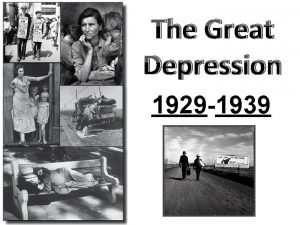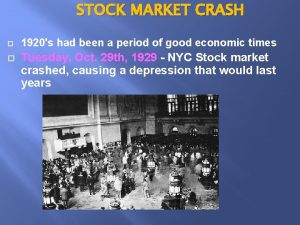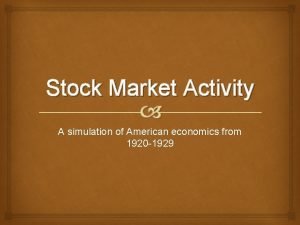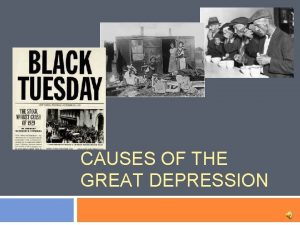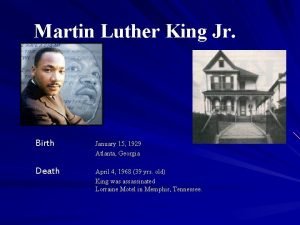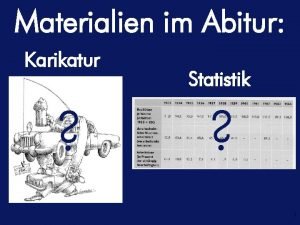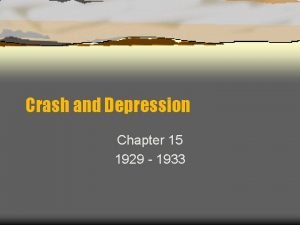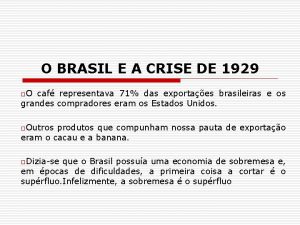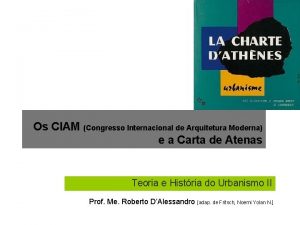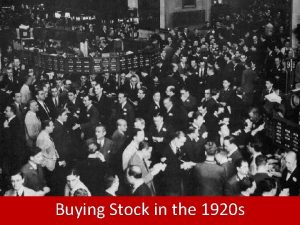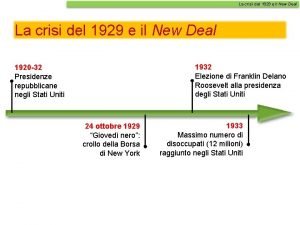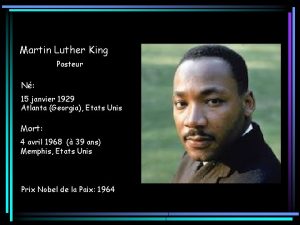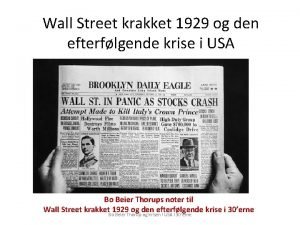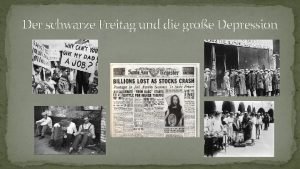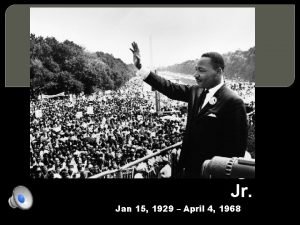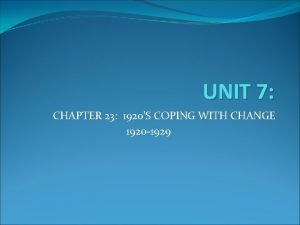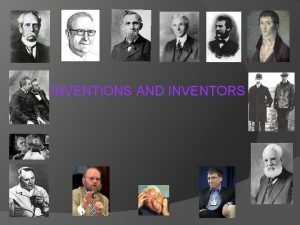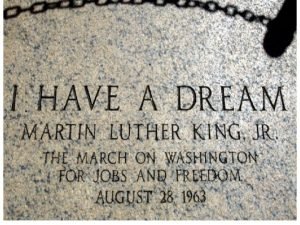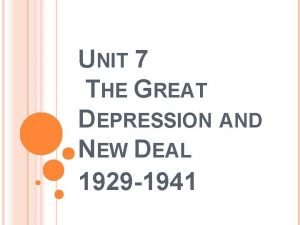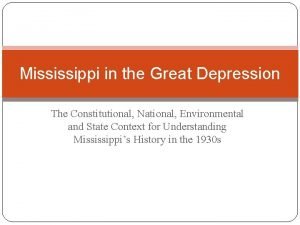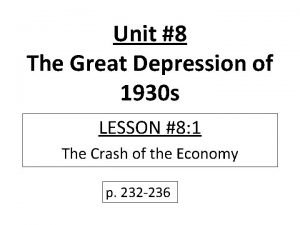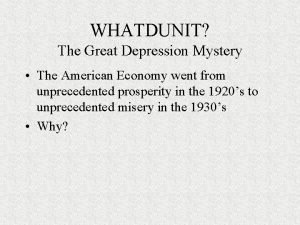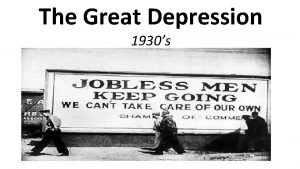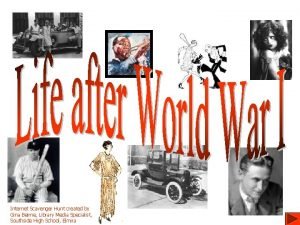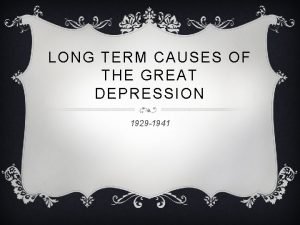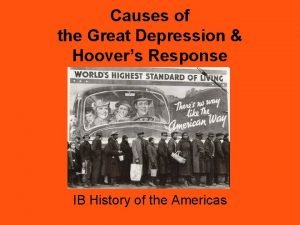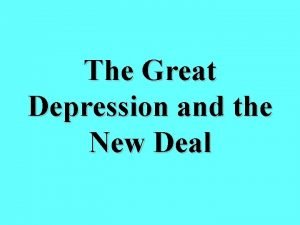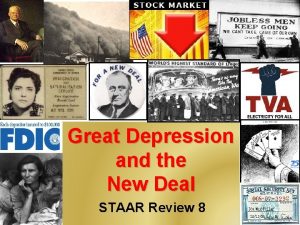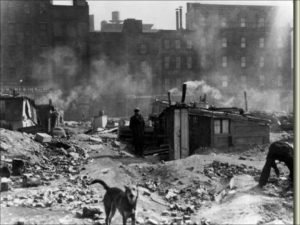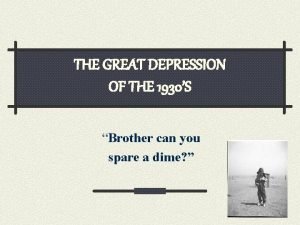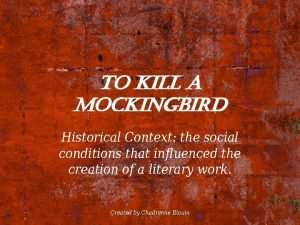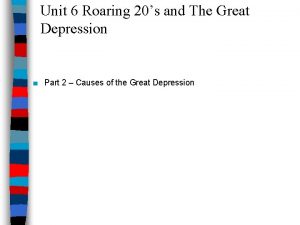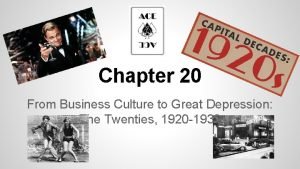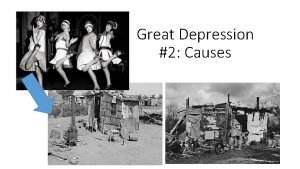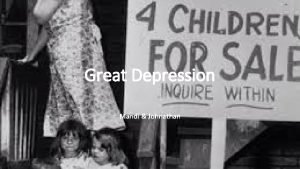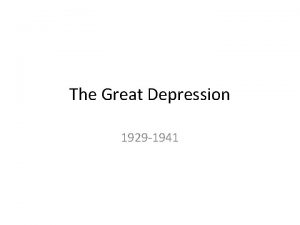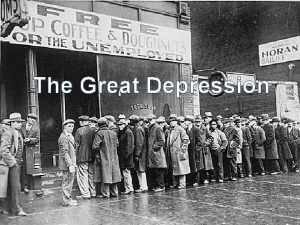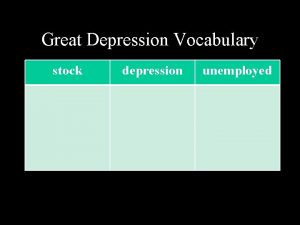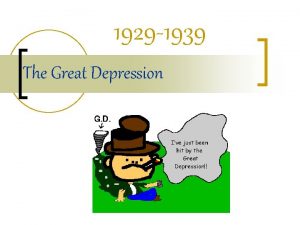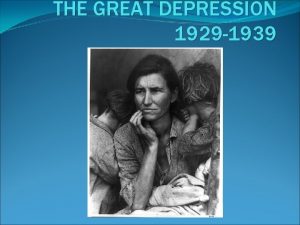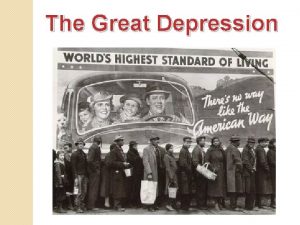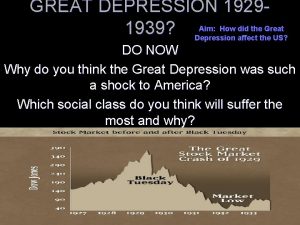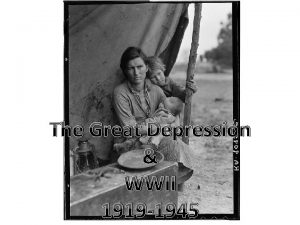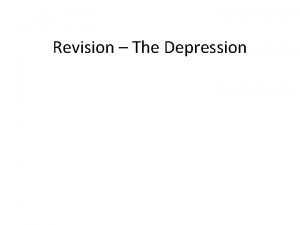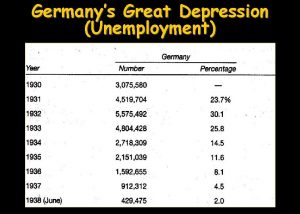The Great Depression 1929 1945 The Great Depression






























































- Slides: 62

The Great Depression 1929 -1945

The Great Depression Leading to the New Deal

The Roaring 20’s Time of unprecedented prosperity in America Problem was: the prosperity was VERY uneven and VERY unregulated ◦ While many Americans experienced increases in their incomes, some experienced HUGE gainscreating a massive unequal distribution of wealth ◦ Businesses and banks were not being watched by the national government leading to problems Businesses were reporting exaggerated gains Banks were lending too much money Calvin Coolidge took away many of the safeguards that existed to protect the American economy

Long Term Causes of the Great Depression 1. Problems with the Stock Market ◦ Businesses reporting exaggerated gains Meant to increase the value of their stocks Led to fast crash of stock prices ◦ High speculation of stock Idea of “Go hard or go home” Belief that you couldn’t make a lot of money if you didn’t risk a lot ◦ Buying on margin The idea of borrowing money to buy stock Not a problem as long as the price of stock continues to go up

Long Term Causes of the Great Depression 2. Problems with the Banks ◦ They were lending out too much money Sometimes over half of the money banks had in reserves was lent out- that means that as soon as a crisis hits, banks would be subject to closures due to people unable to repay their loans They were loaning out too much money to speculators

Long Term Causes of the Great Depression 3. Americans were living in debt Americans living in denial believing that the economy would never slow down and they were not saving New must-haves: radio, automobiles, vacuums Credit: the idea of “buy now, pay later” Installment plans

Long Term Causes of the Great Depression 4. Over Production ◦ Factories American industry had continued to grow since the 1880 s While workers had seen some wage increases, many workers couldn’t afford to buy the products After WWI, there were tariffs and poverty in Europe preventing Europeans from buying American products All of this lead to a massive surplus, leading to lower prices ◦ Farmers They experienced their depression BEFORE the stock market crash American farmers were still producing at the WWI levels when they were growing for Allied powers

Stock Market Crashes OCTOBER 29, 1929 “Black Tuesday” $30 Billon Disappears 8

EFFECT OF DEPRESSION ON CONSUMER SPENDING FROM 1929 T 0 1933 IN BILLIONS OF DOLLARS 9

10

Bank Failures After the crash, many begin withdrawing money from banks ◦ Bank Runs ◦ Banks had invested other people’s moneys ◦ Millions of people lost their life savings Banks closed because withdrawals outnumbered deposits Bank Run


Hoover’s Response to the Great Depression Rugged Individualism Private remedies Hawley-Smoot Tariff Reconstruction Finance Corporation • Increased Public Works spending • The Bonus March • • 13

Rugged Individualism Hoover’s belief that Americans needed to help themselves He argued it wasn’t the role of government to interfere in private business and that what made America great and our businesses so successful was the American drive to take care of ourselves This falls in line with the American belief in laissez faire - or “hands off” of business and the economy

Smoot Hawley Tariff Started out as a fairly reasonable protective tariff ◦ especially designed to help farmers - in 1930 were the most affected Highest protective tariff in America’s peacetime history ◦ Raised the average tariff rate to 60% Tariffs cause: ◦ Average citizens to spend more money ◦ Fewer sales overseas

Reconstruction Finance Corporation As the economic condition in America continued to worsen, Hoover finally took actually establishing the RFC Extended credit to banks, insurance corporations, and large American businesses ◦ Part of “Trickle Down Economics” ◦ Thought was, once businesses improved, hopefully jobs would become available Many Americans resented this- viewed it as “aid to the rich” HOWEVER- this really was the beginning of the first ever government aid…prepared Americans for FDR’s approach

President Hoover finally reacts ◦ Started some public works projects (ex - Boulder Dam) ◦ Too late to make a difference OR to win him reelection

Reaction by Americans Many Americans blamed Hoover for Depression ◦ Those who lost their homes lived in Hoovervilles or Shanty Towns

Soup Kitchen sponsored By a local church

Hooverville

Bonus Army 1932, World War I veterans marched on Washington DC Demanded early payment ◦ Not due until 1945 of bonus Congress denied payment ◦ Some refused to leave Hoover ordered US Army to drive veterans and families out ◦ 2 soldiers and 1 baby killed ◦ Actions cost Hoover the Election of 1932

Bonus Army camped outside US Capital Building

Election of 1932 Franklin Roosevelt (D) won ◦ Promised Americans a New Deal Very vague, but he won ◦ Was inaugurated on March 4, 1932 Too much of a delay Congress passed the 20 th amendment Changed inauguration to January “Lame-duck” amendment


Beliefs Brain Trust- group of advisors put together by FDR to create programs to pull nation out of depression ◦ Begins period known as “Hundred Days” Roosevelt starts trying to “fix” American economy Francis Perkins – 1 st female cabinet member; Sec. of Labor Believed in direct relief Food or money given directly to the people Keynesian Economics Keynes advocated increased government expenditures and lower taxes to stimulate demand would pull the global economy out of the Depression. Deficit Spending

Bank Holiday #1 problem in US was bank failures FDR ordered all banks to close for one week ◦ US Treasury would inspect all banks ◦ Only good banks would re-open ◦ After one week, banks re-opened, deposits outweighed withdrawals for first time since Depression began ◦ Gives fireside chats on radio to reassure Americans FDR increased American confidence in banks

Actions Relief Recovery Reform

New Deal Programs-Alphabet Soup Roosevelt begins other programs to give jobs to Americans or regulate economy Programs use deficit spending (spending more money then the gov’t makes) ◦ Glass-Steagall Act Creates Federal Deposit Insurance Corporation (FDIC) ◦ Federal Securities Act ◦ ◦ ◦ Creates Securities and Exchange Commission (SEC) Agriculture Adjustment Act (AAA) Civilian Conservation Corps (CCC) Tennessee Valley Authority (TVA) Public Works Administration (PWA) National Industrial Recovery Act (NIRA)

2 nd New Deal Roosevelt wants to add more programs in 1935 to build on earlier programs ◦ Works Progress Administration (WPA) ◦ National Youth Administration (NYA) ◦ Wagner Act Sets up National Labor Relations Board ◦ Social Security Act

AGRICULTURAL ADJUSTMENT ACT(AAA) q GOAL WAS TO CREATE A SHORTAGE q AAA PAID $100 MILLION TO PLOW UP 10 OF THE 40 MILLION ACRES PLANTED FOR THE 1933 SEASON. q WHEAT AND CORN FARMERS WERE PAID NOT TO PLANT (SUBSIDIES) q HOGS WERE KILLED TO RAISE PORK PRICES FOR FARMERS. THE AAA PAID FARMERS TO KILL 5 MILLION BABY PIGS AND 200, 000 SOWS. q THE RESULTS OF AAA INTERVENTIONS WERE THAT BY 1936 FARM INCOME WAS UP 50%, SURPLUSES REDUCED AND PRICES ROSE.

NATIONAL INDUSTRIAL RECOVERY ACT (NIRA) ORGANIZED THE NATIONAL RECOVERY ADMINISTRATION (NRA) q ANTI-TRUST LAWS WERE SUSPENDED q 40 -HOUR WORK WEEK, 40 -CENT MINIMUM WAGE q PROTECTED THE RIGHT OF WORKERS TO ORGANIZE AND COLLECTIVE BARGAINING q DECLARED UNCONSTITUTIONAL BY THE SUPREME COURT TWO YEARS LATER IN 1935

PUBLIC WORKS ADMINISTRATION (PWA) SPENT $3. 3 BILLION ON PUBLIC WORKS PROJECTS AS "PUMPPRIMING” TO GET THE ECONOMY MOVING ◦ CONTRUCTION OF SCHOOLS AND GOVERNMENT BUILDINGS 32

PWA GAVE CONSTRUCTION JOBS TO THE UNEMPLOYED 33

FEDERAL EMERGENCY RELIEF ADMINISTRATION (FERA) THIS GAVE EMERGENCY CHECKS DIRECTLY TO UNEMPLOYED PERSONS TO SURVIVE THE WINTER. IT GAVE MATCHING GRANTS TO STATES TO BOLSTER LOCAL RELIEF EFFORTS AND IT SET UP CAMPS FOR UNEMPLOYED WOMEN'S CAMPS FOR UNEMPLOYED WOMEN IN MAINE 34

CIVILIAN CONSERVATION CORPS (CCC) CREATED JOBS IN A SEMI-MILITARY MANNER FOR YOUTH 1825 FROM FAMILIES RECEIVING RELIEF. OVER 2 MILLION YOUNG PEOPLE WERE ENROLLED BY 1941. THEY WERE PAID $30 A MONTH WITH A PORTION BEING SENT TO THEIR FAMILIES. 35

THE CCC HELPED MILLIONS OF YOUNG MEN THROUGHOUT THE DEPRESSION AS WELL AS HELPING THE ENVIRONMENT 36

TENNESSEE VALLEY AUTHORITY (TVA) THE TVA WAS A GREAT SUCCESS BRINGING CHEAP ELECTRIC POWER To WESTERN NC AND EASTERN TN THE TVA IS STILL THE NUMBER ONE PRODUCER OF ELECTRICITY IN THE U. S. 37

CIVIL WORKS ADMINISTRATION (CWA) THE CWA WAS SET UP TO PUT 4, 000 MEN AND WOMEN TO WORK AS SOON AS POSSIBLE. FOUR HUNDRED MILLION DOLLARS OF PUBLIC WORKS FUNDS WERE PROVIDED. BUILD ROADS, AIRPORTS, AND OPERA SINGERS GAVE CONCERTS FOR WORKERS 38

CWA JOBS VARIED, FROM DIGGING NEW SEWER SYSTEMS TO LEADING EXERCISE SESSIONS FOR SCHOOL CHILDREN 39

HOME OWNERS LOAN CORPORATION (HOLC) 19331936 BY THE EARLY 1930’S, HOMEOWNERS WERE LOSING THEIR HOMES DUE TO FORECLOSURES AT THE RATE OF 1, 000 A DAY. HOLC BOUGHT UP MORTGAGES FROM BANKS AND REFINANCED THEM AT RATES THAT ALLOWED HOMEOWNERS TO MAKE LOWER PAYMENTS AND KEEP THEIR HOMES. HOLC SAVED 20% OF HOMEOWNERS FROM LOSING THEIR HOMES DURING THE DEPRESSION 40

BANKING AND STOCK MARKET REGULATIONS $ GLASS-STEAGALL BANKING ACT: JUNE 1933, MADE IT ILLEGAL FOR BANKS TO SPECULATE IN THE STOCK MARKET WITH DEPOSITORS FUNDS. IT SET UP THE FDIC. $ FDIC: FEDERAL DEPOSIT INSURANCE CORPORATION GUARANTEED INDIVIDUAL DEPOSITS. THIS STABILIZED THE BANKING SYSTEM AND PEOPLE BEGAN PUTTING THEIR MONEY IN BANKS AGAIN. $ THE SECURITIES ACT: PASSED IN 1933, AND THE SECURITIES AND EXCHANGE COMMISSION (SEC) PASSED IN 1934 IMPLEMENTED CHANGES THAT CURBED ABUSES IN THE STOCK MARKET.

THE NEW DEAL COMES UNDER ATTACK FROM BOTH THE LEFT AND RIGHT “IT SEEMS CLEAR THE HONEYMOON IS OVER” (HARLAN STONE, SUPREME COURT JUSTICE COMMENTING ON THE GROWING OPPOSITION TO THE NEW DEAL) LEFT LIBERAL THOSE WHO WANTED THE GOVERNMENT TO DO MORE TO END THE DEPRESSION BY INTERVENING IN THE ECONOMY RIGHT CONSERVATIVE THOSE WHO WANTED THE GOVERNMENT TO STAY OUT OF THE ECONOMY AND LET THE DEPRESSION CURE ITSELF

CRITICS FROM THE RIGHT THESE GROUPS FEARED FDR WAS TAKING THE U. S. DOWN THE ROAD TO SOCIALISM AMERICAN LIBERTY LEAGUE IN AUGUST OF 1934, OPPONENTS OF FDR'S NEW DEAL ORGANIZED THE "AMERICAN LIBERTY LEAGUE. " THE LEAGUE STATED THAT IT WOULD WORK TO "DEFEND AND UPHOLD THE CONSTITUTION" AND TO "FOSTER THE RIGHT TO WORK, EARN, SAVE AND ACQUIRE PROPERTY. "

THE LEFT WING CRITICS THEY WERE A MORE DIVERSE AND COLORFUL GROUP WITH NON-TRADITIONAL PLANS FOR ENDING THE DEPRESSION v. HUEY LONG v. FATHER CHARLES COUGHLIN v. FRANCIS E. TOWNSEND v. UPTON SINCLAIR 44

HUEY LONG “EVERY MAN A KING” HUEY WAS GOVERNOR AND LATER A SENATOR FROM LOUISIANA. AS GOVERNOR HE INTRODUCED MANY REFORMS BUT WAS ACCUSED OF ACTING LIKE A DICTATOR. 45

HUEY LONG’S SHARE OUR WEALTH PROGRAM HE WANTED THE FEDERAL GOVERNMENT TO CONFISCATE ALL INCOMES OVER ONE MILLION DOLLARS ($13 MILLION IN 2002 DOLLARS) AND USE THE MONEY TO GIVE EACH FAMILY A HOME AND AN INCOME OF $2000 ($26, 000 IN 2002 DOLLARS) A YEAR. 46

FRANCIS E. TOWNSEND, A DOCTOR IN HIS 60’S CAME UP WITH THE TOWNSEND PLAN WHICH WOULD GIVE EVERYONE OVER 60 $200 ($2523 IN 2002 DOLLARS) A MONTH TO SPEND IN 30 DAYS. 47

FATHER CHARLES COUGHLIN “THE RADIO PRIEST” POPULAR CATHOLIC PRIEST WHO HAD A LARGE RADIO AUDIENCE. HE WAS AN EARLY SUPPORTER OF FDR BUT CHANGED AND BECAME A BITTER CRITIC. HE WAS BOTH AN ANTISEMITE AND ANTI-CAPITALIST "The great betrayer and liar, Franklin D. Roosevelt, who promised to drive the money changers from the temple, had succeeded [only] in driving the farmers from their homesteads and the citizens from their homes in the cities. . . I ask you to purge the man who claims to be a Democrat, from the Democratic Party, and I mean Franklin Double-Crossing Roosevelt. " 48

SECOND NEW DEAL PROGRAMS, 19341936 FHA: FEDERAL HOUSING AUTHORITY WPA: WORKS PROGRESS ADMINISTRATION NATIONAL YOUTH ADMINISTRATION SOCIAL SECURITY FARM PROGRAMS: RESETTLEMENT ADMINISTRATION, FARM SECURITY ADMINISTRATION RURAL ELECTRIFICATION ADMINISTRATION WAGNER ACT: LABOR UNIONS THE REVENUE ACT OF 1935 49

FEDERAL HOUSING ADMINISTRATION (FHA), 1934 THE GOAL OF THE FHA WAS TO IMPROVE HOUSING AND PUT AS MANY AMERICANS INTO THEIR OWN HOMES AS POSSIBLE. IT DID THIS BY ENCOURAGING BANKS TO MAKE LOANS AND FAMILIES TO APPLY FOR THEM.

WORKS PROGRESS ADMINISTRATION (WPA), 1935 THE CWA WAS ENDED IN MARCH OF 1934, WHEN FDR WORRIED IT WAS COSTING TOO MUCH MONEY AND MIGHT CREATE A PERMANENT DEPENDENT CLASS. WHEN THE DEPRESSION CONTINUED HE CREATED THE WPA. IT EMPLOYED 3. 5 MILLION WORKERS AT WAGES BELOW PREVAILING UNION SCALES. IT ALSO HIRED ACTORS, PRODUCRS, AND ARTISTS TO REVITALIZE COMMUNITIES

SOCIAL SECURITY ACT 1935 A SYSTEM OF OLD AGE PENSIONS HAD BEEN ONE OF THE GOALS OF THE PROGRESSIVE MOVEMENT. FDR MADE THIS GOAL A REALITY WITH THE PASSAGE OF THE SOCIAL SECURITY ACT IN 1935. THE ACT CONTAINED SEVERAL PROVISIONS: UNEMPLOYMENT COMPENSATION FOR LAID OFF WORKERS COMPENSATION TO DISABLED WORKERS PAYMENTS TO THE WIVES AND CHILDREN OF DECEASED WORKERS OLD AGE INSURANCE, OFTEN CONSIDERED THE MOST IMPORTANT FEATURE OF THE ACT

FDR AND UNIONS FDR WAS A STRONG SUPPORTER OF UNIONS AND THE RIGHT OF WORKING PEOPLE TO ORGANIZE THE NATIONAL INDUSTRIAL RECOVERY ACT GUARANTEED WORKERS THE RIGHT TO ORGANIZE UNIONS DESPITE THE LAW MANY EMPLOYERS IGNORED IT AND REFUSED TO BARGAIN WITH UNIONS. IN 1935, CONGRESS PASSED THE NATIONAL LABOR RELATIONS ACT ALSO KNOWN AS THE WAGNER ACT WHICH GAVE ENFORCEMENT POWERS TO THE NLRB.

GROWTH IN UNION MEMBERSHIP UNDER FDR 54

ELECTION OF 1936 55

FDR AND THE SUPREME COURT: 1937 “COURT PACKING SCHEME” • • THE SUPREME COURT HAD DECLARED FIVE NEW DEAL PROGRAMS UNCONSTITUTIONAL IN 1935. IN 1936, THE COURT STRUCK DOWN FOUR OTHER NEW DEAL INITIATIVES. FDR BEGAN TO SEE THE SUPREME COURT AS AN ENEMY OF THE NEW DEAL TO COUNTER THE SUPREME COURT'S NEGATIVE RULINGS HE PROPOSED WHAT BECAME KNOWN AS THE “COURT PACKING SCHEME” WHICH WAS A PLAN TO INCREASE THE NUMBER OF FRIENDLY JUSTICES ON THE SUPREME COURT.

New Deal limits & Criticism Supreme Court declares some New Deal acts unconstitutional ◦ National Industry Recovery Aact in 1935 ◦ Agricultural Adjustment Act in 1936 American Liberty League forms to oppose Roosevelt & New Deal policies ◦ Most outspoken were Huey Long (Share-Our. Wealth) & Father Charles Coughlin Roosevelt incident criticized for Court packing ◦ Tried to reorganize court system in 1937 ◦ Would be more “friendly” towards New Deal policies

Other Information Radio & film flourish ◦ Gone with the Wind ◦ The Wizard of Oz ◦ Mr. Smith goes to Washington ◦ “Brother, Can you Spare a Dime” –Woody Guthrie Literature reflects hardships of Depression ◦ John Steinbeck’s Grapes of Wrath

Dust Bowl Over production-land stripped of nutrients Drought-grass Okies and arkies- moved from these states out west to find jobs



End of the Great Depression US doesn’t officially end depression until its entry into WWII ◦ Roosevelt and the New Deal make life better for Americans, but does fix or end the Great Depression
 Great depression 1929
Great depression 1929 Stock market cartoons
Stock market cartoons Stock market crash 1942
Stock market crash 1942 Fun facts about the stock market crash of 1929
Fun facts about the stock market crash of 1929 Ekspresionisti
Ekspresionisti During the great depression there were many wanderers
During the great depression there were many wanderers Deadly wound healed 1929
Deadly wound healed 1929 Midland utilities 1920s
Midland utilities 1920s 1929 trivia
1929 trivia In 1929 the top 5 percent of all american households
In 1929 the top 5 percent of all american households Jan 15 1929
Jan 15 1929 Tectonic plates canada
Tectonic plates canada Karikatur statistik
Karikatur statistik October 29 1929
October 29 1929 1929
1929 Texto com atividades sobre a crise de 1929
Texto com atividades sobre a crise de 1929 Weltwirtschaftskrise ursachen verlauf folgen
Weltwirtschaftskrise ursachen verlauf folgen Mapa mental crise de 1929
Mapa mental crise de 1929 Khủng hoảng kinh tế 1929
Khủng hoảng kinh tế 1929 Sistemi monetar nderkombetar
Sistemi monetar nderkombetar Nazifascismo crise de 1929
Nazifascismo crise de 1929 Crecimiento artificial de la bolsa 1929
Crecimiento artificial de la bolsa 1929 Ciam 1933
Ciam 1933 Berger 1929
Berger 1929 Tel-tone stock 1929
Tel-tone stock 1929 1929
1929 January 15 1929
January 15 1929 Wall street krakket
Wall street krakket Schwarzer freitag 1929 datum
Schwarzer freitag 1929 datum January 15, 1929
January 15, 1929 Deadly wound healed 1929
Deadly wound healed 1929 Hrvatska književnost od 1914 do 1952
Hrvatska književnost od 1914 do 1952 Calvin coolidge
Calvin coolidge Jayakar committee
Jayakar committee John logie baird discovered penicillin in 1929
John logie baird discovered penicillin in 1929 15 janvier 1929
15 janvier 1929 Stock market crash in 1929
Stock market crash in 1929 Great depression kinetic sculpture
Great depression kinetic sculpture Great depression causes
Great depression causes The great depression summary
The great depression summary Great depression
Great depression Rarig great depression
Rarig great depression Compare and contrast president hoover and roosevelt
Compare and contrast president hoover and roosevelt Laissez faire great depression
Laissez faire great depression Overspeculation great depression
Overspeculation great depression Great depression
Great depression Ww1 to great depression cloze notes
Ww1 to great depression cloze notes Roaring twenties scavenger hunt answers
Roaring twenties scavenger hunt answers What were the long term causes of the great depression
What were the long term causes of the great depression What is the dawes plan
What is the dawes plan What was hoover's response to the great depression
What was hoover's response to the great depression Five effects of the great depression
Five effects of the great depression Great depression political cartoons
Great depression political cartoons Chapter 22 the great depression begins
Chapter 22 the great depression begins Great depression budget activity
Great depression budget activity What does aaa stand for great depression
What does aaa stand for great depression Brief summary of the great depression
Brief summary of the great depression Hoover's response to the great depression
Hoover's response to the great depression Cpi during the great depression
Cpi during the great depression Dust bowl map
Dust bowl map Social context of to kill a mockingbird
Social context of to kill a mockingbird Great depression
Great depression Chapter 20 from business culture to great depression
Chapter 20 from business culture to great depression
